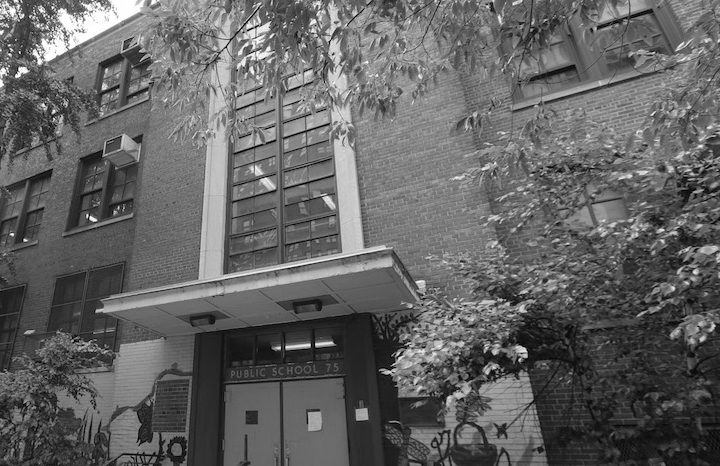
Public School 75 (The Emily Dickinson School)-735 West End Avenue
by Tom Miller
On December 23, 1948, The New York Times reported that the Board of Education had broken ground for Public School 93, at the northwest corner of West End Avenue and 95th Street. “The new elementary school will replace the present Public School 93 at Ninety-Third Street and Amsterdam Avenue, which was erected in 1891,” said the article.
By the time construction was completed two years later, the school had been renumbered Public School 75. Designed by architect Eric Kebbon, it cost the city $1,906,064 to erect (about $24.8 million in 2025) and could accommodate 1,309 students. The New York Times reported that its “new type elementary classrooms” were 35-feet-long, “or seven feet longer than the former standard.” Kebbon’s H-shaped plan created two play yards on the sides. Because of the significant decline of West End Avenue, Kebbon designed its front in three visual parts—two three-story wings connected by a tall section that held the entrance under a cantilever marquee. Above it, a soaring bay of glass panes was framed in stone.
In response, the children of P.S. 75 (and all other school children throughout the U.S.) were trained in “drop and cover” drills.
The school opened on September 11, 1950. Three years earlier, diplomatic relations between the United States and the Soviet Union essentially collapsed, resulting in what was known as the Cold War. In response, the children of P.S. 75 (and all other school children throughout the U.S.) were trained in “drop and cover” drills. On February 8, 1951, The New York Times reported:
At 10:45 A.M. Mrs. Bertha Smith, a sixth-grade teacher in Public School 75 at 735 West End Avenue, observed a hypothetical “sudden white flash” and gave the “take cover” signal to her class. Almost immediately the youngsters dropped to the floor, their backs to the windows, and covered the exposed parts of their bodies. It took only a fraction of a second. When Mrs. Smith gave the “all clear” the youngsters came up beaming.
The drill was to prepare students for the event of a bomb attack. A visitor to the school asked if they were playing a game. Eleven-year-old Jeanette Silverman replied quite gravely, “Oh, no. We were taking cover in case of a sneak attack.”
Interestingly, the office of Assistant Superintendent of Schools, Benjamin B. Greenberg was in the building. Greenberg had begun his career in the New York Public School system in 1906 as a teacher “of maladjusted boys.” After serving the city for 50 years, he retired at the end of the 1956 school year.
In 1960, six-year-old Blanca De La Rosa enrolled in P.S. 75. Born in the Dominican Republic, her family had just immigrated to New York City. Although she spoke no English, she gradually thrived. “I can honestly say that I do not remember when I learned to speak, read, and write English. But what I can say is that my kind first-grade teacher put me on the right path,” she recounts in her Pursuing a Better Tomorrow. De La Rosa would graduate from Pace University and become the Business Development Manager of ExxonMobil, and an author.
The 1960s was a time of upheaval and protests and the parents (and children) of Public School 75 reflected the times. On November 25, 1964, The New York Times headlined an article, “Kindergarten Children Picket to Save Class.” The article reported on the “junior picket line” at lunchtime in protest of the cancellation of a kindergarten class (the school was short 20 children to support the additional class). “About 30 mothers and children marched in front of the school at lunch time yesterday to draw attention to the campaign,” said the article.
Six years later, the parents and students were protesting again—this time concerning the crosswalk at West End Avenue and 96th Street. One hundred parents blocked traffic for more than two hours “to protest hazards their children face in going to school,” reported The Times on December 15, 1970. One mother, Esther Rosenfeld, said, “it just shows that the only way you can get anything done in this city is to make a fuss, to make a lot of noise.” Among the placard-carrying “phalanx” that blocked the intersections was the school’s principal, Luis Mercado, who said, “Nobody has been killed here yet, but we have close calls every day.”
… they quit their jobs and started the hard rock band Kiss.
And on September 26, 1972, parents kept their children home in what they called “a one-day boycott.” The Board of Education had changed the rules concerning substitute teachers. The New York Times reported, “Hundreds of parents and children paraded yesterday outside the school…carrying signs reading, ‘Keep Our Teachers’ and “Save Our Teachers—if they Go, We go.’”
In the meantime, a new sixth grade teacher had arrived at P.S. 75 in the fall of 1970. Chaim Witz had received his teaching degree from Richmond College on Staten Island that year. The part-time musician’s tenure at the school would be short lived. Shortly after starting, he met Stanley Eisen. Witz changed his name to Gene Simmons, Eisen changed his to Paul Stanley, and six months after Witz aka Simmons started teaching in P.S. 75, and they quit their jobs and started the hard rock band Kiss.
Luis Mercado, who had carried a sign and blocked traffic in December 1970, was reassigned to the Board of Education headquarters on April 3, 1989. The New York Times reported that he was “being investigated on charges of illegally selling a prescription drug to teachers and parents.” The drugs were not amphetamines or similar dangerous substances. He was accused of selling Retin-A, an anti-acne cream. The Board of Education added (as sort of a side note) that he was “also being investigated over complaints that he had used school property to sell Mexican paintings.” He was later dismissed.
In 1993 and 1995, Public School 75 (by now also known as the Emily Dickinson School) was included in Redbook magazine’s list of the “91 schools in the country recognized for overall excellence.” In 2025, U.S. News & World Report noted that the “award winning” school had a minority student enrollment of 77 percent. Because of that, the school offers Spanish Dual Language classes
Tom Miller is a social historian and blogger at https://daytoninmanhattan.blogspot.com/
Explore more West End Avenue!
Building Database
Explore Even More!
Read more about this landmark from our partners at the NYC LGBT Historic Sites Project!
NYC LGBT Historic Sites Project Site History


